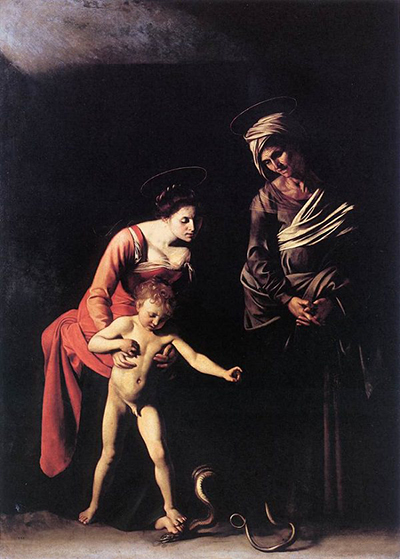Caravaggio was a master of Baroque in Italy. He produced the Madonna and Child with St Anne (DeIpalafrenieri) which is a mature religious work painted in 1605-1606 as a holy place of safety and refuge for the ark confraternity.
The painting of Palafrenieriwas done in Borgo, a location which was close to Vatican, on the Via Di Porta Angelika it was made using dramatic shade and light and was very decorated unlike the kind of painting that was there by then. The painting was later removed due to the assumption that its virgin portrayal was unorthodox. It was then sold to Cardinal Scipione Borghese who is the arts patron and an Italian cardinal and is now hanged in his palazzo (Galleria Borghese) in his gallery of castle arts in Rome.
The painting is in the same place with other paintings made by Caravaggio. They include: Young Sick Bacchus, the desert Baptist who is St John, the writing of St Jerome, goliaths head, the virgin crucifix's death, a basket full of fruits with a boy, Saint paint conversion, the St Peter's crucifix, the Beheading of Holofernes by Judith and the Saint Matthew martyrdom. Meanwhile, it wasn't his most successful arrangement; it is the typical representation of the person abstaining from sexual relations for its time and must have been shocking to some of the existing viewers. The allegory at its core is simple.
With the aid of her son, she destroys the serpent, which is the pictorial representation of evil or the origin of Sin. Saint Anne, whom the painting is primarily intended to honor, is a wrinkled old grandmother, witnessing the event. Insubstantial halos crown the upright, the snake recoils in anti-hallows. Both Mary and Jesus are barefoot as drawn. The naked uncircumcised child represents Jesus. The rest is mainly shadow, and the figures gain imposing in the light.
The painting was not meant to honor the grandmother of Christ as it is not clear how the ungracious defection of her wrinkled visage in this painting would have been seen as relevant or iconic. Bellori stated there was more shock experienced as the Virgin Mary clothes covering from the waist to the neck were very revealing. Jesus's leg and phallus parallel diagonals led to speculation that there was battling of the snake from the both and with one, this was metaphorically equal or figurative equal.




